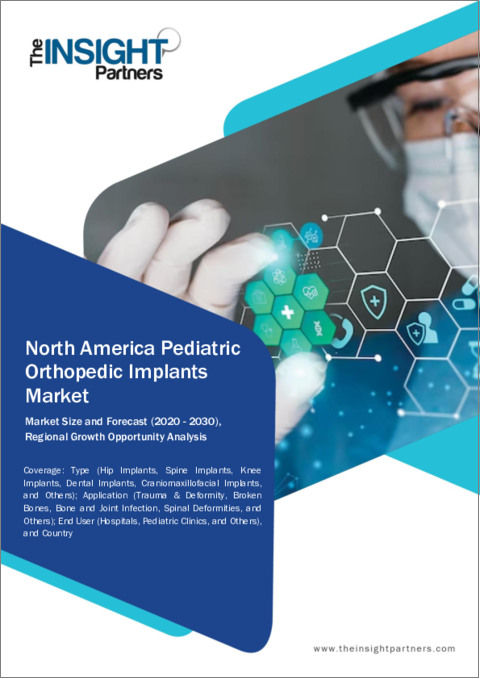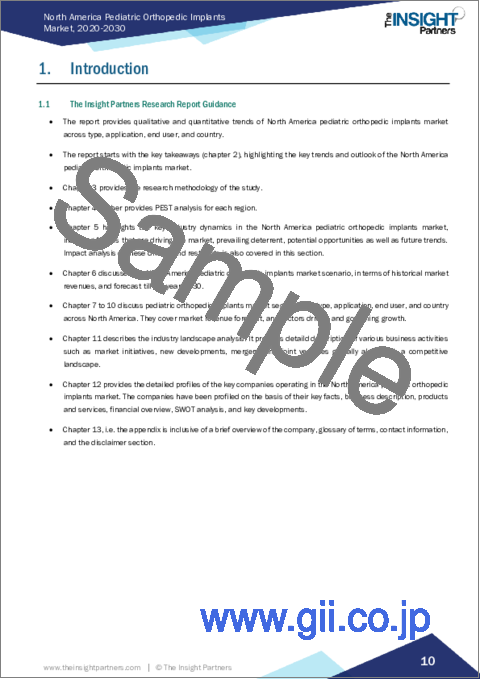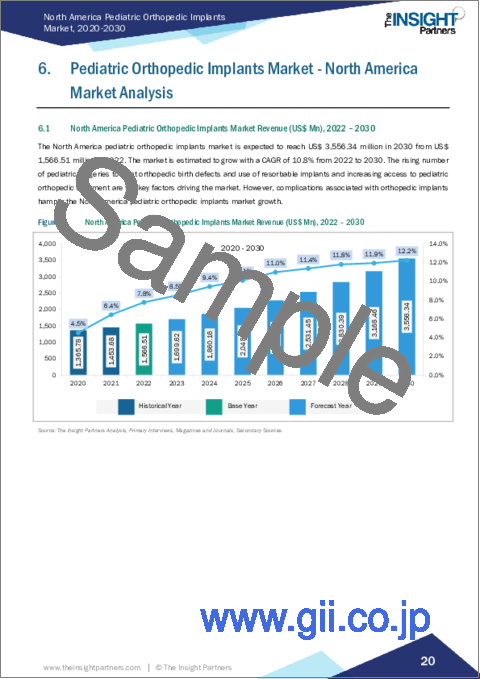|
|
市場調査レポート
商品コード
1463605
北米の小児整形外科用インプラント:2030年までの市場予測 - 地域分析 - タイプ、用途、エンドユーザー別North America Pediatric Orthopedic Implants Market Forecast to 2030 - Regional Analysis - by Type, Application, and End User |
||||||
|
|||||||
| 北米の小児整形外科用インプラント:2030年までの市場予測 - 地域分析 - タイプ、用途、エンドユーザー別 |
|
出版日: 2024年01月23日
発行: The Insight Partners
ページ情報: 英文 70 Pages
納期: 即納可能
|
全表示
- 概要
- 図表
- 目次
北米の小児整形外科用インプラント市場は、2022年に15億6,651万米ドルと評価され、2030年には35億5,634万米ドルに達すると予測され、2022年から2030年までのCAGRは10.8%で成長すると予測されています。
整形外科的先天性欠損症治療のための小児手術件数の増加が北米の小児整形外科用インプラント市場を後押し
整形外科的欠損症は、筋肉、骨格、関連組織に影響を及ぼす後天的または先天的な異常です。これらの異常は主に、筋肉の不均衡、麻痺、下肢の感覚低下をもたらします。先天性の整形外科的障害には、内反足、脊椎変形、骨形成不全、筋ジストロフィー、四肢欠損、骨感染症などがあります。股関節脱臼の原因となる発育不全や、彎曲足や内反足の原因となる外反母趾も、先天性整形外科的障害に分類されます。
整形外科的先天性障害の有病率の増加が、北米の小児整形外科用インプラント市場の成長を牽引しています。米国疾病管理有病率センター(CDC)によると、内反足は米国で最も一般的な先天性障害の一つであり、2022年には国内で~6,643人の赤ちゃんに影響を与えました。親から受け継いだ遺伝子の異常や、子孫に遺伝子の欠損や異常をもたらす染色体異常は、整形外科的先天異常の顕著な原因のひとつです。さらに、これらの障害の早期診断と治療をサポートするツールや技術が利用可能になることで、患者の転帰が改善され、ひいては小児整形外科用インプラントの採用が促進されます。さらに、小児外傷の症例は過去10年間で増加しています。Cureusに掲載された記事によると、子供たちの野外活動の急増や事故による怪我の増加などの要因が、小児外傷の有病率を高め続けており、これは今後数年間、北米の小児整形外科用インプラント市場に利益をもたらし続けると思われます。
北米の小児整形外科用インプラント市場概要
北米の小児整形外科用インプラント市場は、米国、カナダ、メキシコにセグメント化されます。北米の市場成長は、出生時の奇形症例の増加と、この地域で事業を展開する主要市場プレーヤーによる成長戦略の実行の高まりに起因しています。加えて、主要国における医療支出の増加が、予測期間中の同地域の市場成長を促進すると思われます。
北米の小児整形外科用インプラント市場の収益と2030年までの予測(US$Mn)
北米の小児整形外科用インプラント市場セグメンテーション
北米の小児整形外科用インプラント市場は、タイプ、用途、エンドユーザー、国別にセグメント化されています。
タイプ別では、北米の小児整形外科用インプラント市場は、股関節インプラント、脊椎インプラント、膝関節インプラント、歯科インプラント、頭蓋顎顔面インプラント、その他に区分されます。2022年には、股関節インプラント分野が最大の市場シェアを占めました。
用途別では、北米の小児整形外科用インプラント市場は、外傷・奇形、骨折、骨・関節感染症、脊椎奇形、その他に区分されます。外傷・奇形分野が2022年に最大の市場シェアを占めました。
エンドユーザー別では、北米の小児整形外科用インプラント市場は病院、小児クリニック、その他に区分されます。病院セグメントが2022年に最大の市場シェアを占めました。
国別では、北米の小児整形外科用インプラント市場は米国、カナダ、メキシコに区分されます。2022年の北米の小児整形外科用インプラント市場シェアは米国が独占しました。
Arthrex Inc、Johnson &Johnson、OrthoPediatrics Corp、Stryker Corp、WishBone Medical Incは、北米の小児整形外科用インプラント市場で事業を展開している大手企業です。
目次
第1章 イントロダクション
第2章 エグゼクティブサマリー
- 主要な洞察
第3章 調査手法
- 調査範囲
- 2次調査
- 1次調査
第4章 北米の小児整形外科用インプラント市場情勢
第5章 北米の小児整形外科用インプラント市場:主要産業力学
- 市場促進要因
- 整形外科的先天性欠損症治療のための小児手術件数の増加
- 再吸収性インプラントの使用と小児整形外科治療へのアクセスの増加
- 市場抑制要因
- 整形外科インプラントに伴う合併症
- 市場機会
- 小児整形外科患者のアンメットニーズ
- 今後の動向
- 整形外科用インプラントの技術的進歩
- 影響分析
第6章 小児整形外科用インプラント市場:北米市場分析
- 北米の小児整形外科用インプラント市場収益、2022年~2030年
第7章 北米の小児整形外科用インプラント市場 - 収益と2030年までの予測:タイプ別
- 市場収益シェア、2022年および2030年
- 股関節インプラント
- 脊椎インプラント
- 膝インプラント
- 歯科インプラント
- 頭蓋顎顔面インプラント
- その他
第8章 北米の小児整形外科用インプラント市場 - 収益と2030年までの予測:用途別
- 市場収益シェア、2022年および2030年
- 外傷と奇形
- 骨折
- 骨・関節感染
- 脊椎変形
- その他
第9章 北米の小児整形外科用インプラント市場 - 収益と2030年までの予測:エンドユーザー別
- 市場収益シェア、2022年および2030年
- 病院
- 小児科クリニック
- その他
第10章 北米の小児整形外科用インプラント市場:国別分析
- 米国
- カナダ
- メキシコ
第11章 業界情勢
- 小児整形外科用インプラント市場における成長戦略、2020~2023年
- 無機的成長戦略
- 有機的成長戦略
第12章 企業プロファイル
- Johnson & Johnson
- Arthrex Inc
- Stryker Corp
- OrthoPediatrics Corp
- WishBone Medical Inc
第13章 付録
List Of Tables
- Table 1. North America Pediatric Orthopedic Implants Market Segmentation
- Table 2. US: North America Pediatric Orthopedic Implants Market, by Type - Revenue and Forecast to 2030 (US$ Million)
- Table 3. US: North America Pediatric Orthopedic Implants Market, by Application - Revenue and Forecast to 2030 (US$ Million)
- Table 4. US: North America Pediatric Orthopedic Implants Market, by End User - Revenue and Forecast to 2030 (US$ Million)
- Table 5. Canada: North America Pediatric Orthopedic Implants Market, by Type - Revenue and Forecast to 2030 (US$ Million)
- Table 6. Canada: North America Pediatric Orthopedic Implants Market, by Application - Revenue and Forecast to 2030 (US$ Million)
- Table 7. Canada: North America Pediatric Orthopedic Implants Market, by End User - Revenue and Forecast to 2030 (US$ Million)
- Table 8. Mexico: North America Pediatric Orthopedic Implants Market, by Type - Revenue and Forecast to 2030 (US$ Million)
- Table 9. Mexico: North America Pediatric Orthopedic Implants Market, by Application - Revenue and Forecast to 2030 (US$ Million)
- Table 10. Mexico: North America Pediatric Orthopedic Implants Market, by End User - Revenue and Forecast to 2030 (US$ Million)
- Table 11. Recent Inorganic Growth Strategies in the North America Pediatric Orthopedic Implants Market
- Table 12. Recent Organic Growth Strategies in The North America Pediatric Orthopedic Implants Market
- Table 13. Glossary of Terms, North America Pediatric Orthopedic Implants Market
List Of Figures
- Figure 1. North America Pediatric Orthopedic Implants Market Segmentation, By Country
- Figure 2. North America Pediatric Orthopedic Implants Market - Key Industry Dynamics
- Figure 3. Impact Analysis of Drivers and Restraints
- Figure 4. North America Pediatric Orthopedic Implants Market Revenue (US$ Mn), 2022 - 2030
- Figure 5. North America Pediatric Orthopedic Implants Market Revenue Share, by Type, 2022 & 2030 (%)
- Figure 6. Hip Implants: North America Pediatric Orthopedic Implants Market - Revenue and Forecast to 2030 (US$ Million)
- Figure 7. Spine Implants: North America Pediatric Orthopedic Implants Market - Revenue and Forecast to 2030 (US$ Million)
- Figure 8. Knee Implants: North America Pediatric Orthopedic Implants Market - Revenue and Forecast to 2030 (US$ Million)
- Figure 9. Dental Implants: North America Pediatric Orthopedic Implants Market - Revenue and Forecast to 2030 (US$ Million)
- Figure 10. Craniomaxillofacial Implants: North America Pediatric Orthopedic Implants Market - Revenue and Forecast to 2030 (US$ Million)
- Figure 11. Others: North America Pediatric Orthopedic Implants Market - Revenue and Forecast to 2030 (US$ Million)
- Figure 12. North America Pediatric Orthopedic Implants Market Revenue Share, by Application 2022 & 2030 (%)
- Figure 13. Trauma & Deformity: North America Pediatric Orthopedic Implants Market - Revenue and Forecast to 2030 (US$ Million)
- Figure 14. Broken Bones: North America Pediatric Orthopedic Implants Market - Revenue and Forecast to 2030 (US$ Million)
- Figure 15. Bone and Joint Infection: North America Pediatric Orthopedic Implants Market - Revenue and Forecast to 2030 (US$ Million)
- Figure 16. Spinal Deformities: North America Pediatric Orthopedic Implants Market - Revenue and Forecast to 2030 (US$ Million)
- Figure 17. Others: North America Pediatric Orthopedic Implants Market - Revenue and Forecast to 2030 (US$ Million)
- Figure 18. North America Pediatric Orthopedic Implants Market Revenue Share, by End User, 2022 & 2030 (%)
- Figure 19. Hospitals: North America Pediatric Orthopedic Implants Market - Revenue and Forecast to 2030 (US$ Million)
- Figure 20. Pediatric Clinics: North America Pediatric Orthopedic Implants Market - Revenue and Forecast to 2030 (US$ Million)
- Figure 21. Others: North America Pediatric Orthopedic Implants Market - Revenue and Forecast to 2030 (US$ Million)
- Figure 22. North America Pediatric Orthopedic Implants Market, by Key Country - Revenue (2022) (US$ Million)
- Figure 23. North America Pediatric Orthopedic Implants Market, By Key Countries, 2022 and 2030 (%)
- Figure 24. US: North America Pediatric Orthopedic Implants Market Revenue and Forecast to 2030 (US$ Mn)
- Figure 25. Canada: North America Pediatric Orthopedic Implants Market Revenue and Forecast to 2030 (US$ Mn)
- Figure 26. Mexico: North America Pediatric Orthopedic Implants Market Revenue and Forecast to 2030 (US$ Mn)
- Figure 27. Growth Strategies in The Pediatric Orthopedic Implants Market, 2020-2023
The North America pediatric orthopedic implants market was valued at US$ 1,566.51 million in 2022 and is expected to reach US$ 3,556.34 million by 2030; it is estimated to grow at a CAGR of 10.8% from 2022 to 2030.
Rising Number of Pediatric Surgeries to Treat Orthopedic Birth Defects Fuels the North America Pediatric Orthopedic Implants Market
Orthopedic defects are acquired or congenital abnormalities that affect the muscles, skeleton, and related tissues. These abnormalities predominantly result in muscle imbalance, paralysis, and decreased sensation in the lower extremity. The congenital orthopedic disabilities include clubfoot, spine deformities, osteogenesis imperfecta, muscular dystrophy, limb defects, and bone infections. Developmental dysplasia causing hip dislocation and metatarsus adducts causing curved foot or in-toeing are also categorized as congenital orthopedic disabilities.
An increase in the prevalence of orthopedic birth defects drives the growth of the North America pediatric orthopedic implants market. According to the Centers for Disease Control and Prevalence (CDC), clubfoot is one of the most common birth defects in the US, and it affected ~6,643 babies in the country in 2022. Abnormal genes inherited from a parent and chromosomal disorders leading to a missing or abnormal gene in offspring are among the notable causes of orthopedic birth defects. Moreover, the availability of tools and technologies that support the early diagnosis and treatment of these disorders contribute to better patient outcomes, in turn, bolstering the adoption of pediatric orthopedic implants. Additionally, pediatric trauma cases have increased over the past decade. According to an article published in Cureus, factors such as a surge in outdoor activities among children and the growing number of accidental injuries continue to boost the prevalence of pediatric trauma, which would continue to benefit the North America pediatric orthopedic implants market in the coming years.
North America Pediatric Orthopedic Implants Market Overview
The North America pediatric orthopedic implants market is segmented into the US, Canada, and Mexico; the US held the largest share of the market in this region. The market growth in North America is attributed to the increasing cases of birth deformities and the rising implementation of growth strategies by key market players operating in this region. In addition, the growing health expenditures in major countries would drive market growth in the region during the forecast period.
North America Pediatric Orthopedic Implants Market Revenue and Forecast to 2030 (US$ Mn)
North America Pediatric Orthopedic Implants Market Segmentation
The North America pediatric orthopedic implants market is segmented type, application, end user, and country.
Based on type, the North America pediatric orthopedic implants market is segmented into hip implants, spine implants, knee implants, dental implants, craniomaxillofacial implants, and others. The hip implants segment held the largest market share in 2022.
Based on application, the North America pediatric orthopedic implants market is segmented into trauma and deformities, broken bones, bone and joint infections, spinal deformities, and others. The trauma and deformities segment held the largest market share in 2022.
Based on end user, the North America pediatric orthopedic implants market is segmented into hospitals, pediatric clinics, and others. The hospitals segment held the largest market share in 2022.
Based on country, the North America pediatric orthopedic implants market is segmented into the US, Canada, and Mexico. The US dominated the North America pediatric orthopedic implants market share in 2022.
Arthrex Inc, Johnson & Johnson, OrthoPediatrics Corp, Stryker Corp, and WishBone Medical Inc are some of the leading companies operating in the North America pediatric orthopedic implants market.
Table Of Contents
1. Introduction
- 1.1 The Insight Partners Research Report Guidance
- 1.2 Market Segmentation
2. Executive Summary
- 2.1 Key Insights
3. Research Methodology
- 3.1 Coverage
- 3.2 Secondary Research
- 3.3 Primary Research
4. North America Pediatric Orthopedic Implants Market Landscape
- 4.1 Overview
5. North America Pediatric Orthopedic Implants Market - Key Industry Dynamics
- 5.1 Market Drivers
- 5.1.1 Rising Number of Pediatric Surgeries to Treat Orthopedic Birth Defects
- 5.1.2 Use of Resorbable Implants and Increasing Access to Pediatric Orthopedic Treatment
- 5.2 Market Restraints
- 5.2.1 Complications Associated with Orthopedic Implants
- 5.3 Market Opportunities
- 5.3.1 Unmet Needs of Pediatric Orthopedic Patients
- 5.4 Future Trends
- 5.4.1 Technological Advancements in Orthopedic Implants
- 5.5 Impact Analysis
6. Pediatric Orthopedic Implants Market - North America Market Analysis
- 6.1 North America Pediatric Orthopedic Implants Market Revenue (US$ Mn), 2022 - 2030
7. North America Pediatric Orthopedic Implants Market - Revenue and Forecast to 2030 - by Type
- 7.1 Overview
- 7.2 North America Pediatric Orthopedic Implants Market Revenue Share, by Type, 2022 & 2030 (%)
- 7.3 Hip Implants
- 7.3.1 Overview
- 7.3.2 Hip Implants: North America Pediatric Orthopedic Implants Market - Revenue and Forecast to 2030 (US$ Million)
- 7.4 Spine Implants
- 7.4.1 Overview
- 7.4.2 Spine Implants: North America Pediatric Orthopedic Implants Market - Revenue and Forecast to 2030 (US$ Million)
- 7.5 Knee Implants
- 7.5.1 Overview
- 7.5.2 Knee Implants: North America Pediatric Orthopedic Implants Market - Revenue and Forecast to 2030 (US$ Million)
- 7.6 Dental Implants
- 7.6.1 Overview
- 7.6.2 Dental Implants: North America Pediatric Orthopedic Implants Market - Revenue and Forecast to 2030 (US$ Million)
- 7.7 Craniomaxillofacial Implants
- 7.7.1 Overview
- 7.7.2 Craniomaxillofacial Implants: North America Pediatric Orthopedic Implants Market - Revenue and Forecast to 2030 (US$ Million)
- 7.8 Others
- 7.8.1 Overview
- 7.8.2 Others: North America Pediatric Orthopedic Implants Market - Revenue and Forecast to 2030 (US$ Million)
8. North America Pediatric Orthopedic Implants Market - Revenue and Forecast to 2030 - by Application
- 8.1 Overview
- 8.2 North America Pediatric Orthopedic Implants Market Revenue Share, by Application 2022 & 2030 (%)
- 8.3 Trauma & Deformity
- 8.3.1 Overview
- 8.3.2 Trauma & Deformity: North America Pediatric Orthopedic Implants Market - Revenue and Forecast to 2030 (US$ Million)
- 8.4 Broken Bones
- 8.4.1 Overview
- 8.4.2 Broken Bones: North America Pediatric Orthopedic Implants Market - Revenue and Forecast to 2030 (US$ Million)
- 8.5 Bone and Joint Infection
- 8.5.1 Overview
- 8.5.2 Bone and Joint Infection: North America Pediatric Orthopedic Implants Market - Revenue and Forecast to 2030 (US$ Million)
- 8.6 Spinal Deformities
- 8.6.1 Overview
- 8.6.2 Spinal Deformities: North America Pediatric Orthopedic Implants Market - Revenue and Forecast to 2030 (US$ Million)
- 8.7 Others
- 8.7.1 Overview
- 8.7.2 Others: North America Pediatric Orthopedic Implants Market - Revenue and Forecast to 2030 (US$ Million)
9. North America Pediatric Orthopedic Implants Market - Revenue and Forecast to 2030 - by End User
- 9.1 Overview
- 9.2 North America Pediatric Orthopedic Implants Market Revenue Share, by End User, 2022 & 2030 (%)
- 9.3 Hospitals
- 9.3.1 Overview
- 9.3.2 Hospitals: North America Pediatric Orthopedic Implants Market - Revenue and Forecast to 2030 (US$ Million)
- 9.4 Pediatric Clinics
- 9.4.1 Overview
- 9.4.2 Pediatric Clinics: North America Pediatric Orthopedic Implants Market - Revenue and Forecast to 2030 (US$ Million)
- 9.5 Others
- 9.5.1 Overview
- 9.5.2 Others: North America Pediatric Orthopedic Implants Market - Revenue and Forecast to 2030 (US$ Million)
10. North America Pediatric Orthopedic Implants Market - Country Analysis
- 10.1 Overview
- 10.1.1 North America Pediatric Orthopedic Implants Market, by Country
- 10.1.1.1 US
- 10.1.1.1.1 Overview
- 10.1.1.1.2 US: North America Pediatric Orthopedic Implants Market Revenue and Forecast to 2030 (US$ Mn)
- 10.1.1.1.3 US: North America Pediatric Orthopedic Implants Market, by Type, 2020-2030 (US$ Million)
- 10.1.1.1.4 US: North America Pediatric Orthopedic Implants Market, by Application, 2020-2030 (US$ Million)
- 10.1.1.1.5 US: North America Pediatric Orthopedic Implants Market, by End User, 2020-2030 (US$ Million)
- 10.1.1.2 Canada
- 10.1.1.2.1 Overview
- 10.1.1.2.2 Canada: North America Pediatric Orthopedic Implants Market Revenue and Forecast to 2030 (US$ Mn)
- 10.1.1.2.3 Canada: North America Pediatric Orthopedic Implants Market, by Type, 2020-2030 (US$ Million)
- 10.1.1.2.4 Canada: North America Pediatric Orthopedic Implants Market, by Application, 2020-2030 (US$ Million)
- 10.1.1.2.5 Canada: North America Pediatric Orthopedic Implants Market, by End User, 2020-2030 (US$ Million)
- 10.1.1.3 Mexico
- 10.1.1.3.1 Overview
- 10.1.1.3.2 Mexico: North America Pediatric Orthopedic Implants Market Revenue and Forecast to 2030 (US$ Mn)
- 10.1.1.3.3 Mexico: North America Pediatric Orthopedic Implants Market, by Type, 2020-2030 (US$ Million)
- 10.1.1.3.4 Mexico: North America Pediatric Orthopedic Implants Market, by Application, 2020-2030 (US$ Million)
- 10.1.1.3.5 Mexico: North America Pediatric Orthopedic Implants Market, by End User, 2020-2030 (US$ Million)
- 10.1.1.1 US
- 10.1.1 North America Pediatric Orthopedic Implants Market, by Country
11. Industry Landscape
- 11.1 Overview
- 11.2 Growth Strategies in The Pediatric Orthopedic Implants Market, 2020-2023
- 11.3 Inorganic Growth Strategies
- 11.3.1 Overview
- 11.4 Organic Growth Strategies
- 11.4.1 Overview
12. Company Profiles
- 12.1 Johnson & Johnson
- 12.1.1 Key Facts
- 12.1.2 Business Description
- 12.1.3 Products and Services
- 12.1.4 Financial Overview
- 12.1.5 SWOT Analysis
- 12.1.6 Key Developments
- 12.2 Arthrex Inc
- 12.2.1 Key Facts
- 12.2.2 Business Description
- 12.2.3 Products and Services
- 12.2.4 Financial Overview
- 12.2.5 SWOT Analysis
- 12.2.6 Key Developments
- 12.3 Stryker Corp
- 12.3.1 Key Facts
- 12.3.2 Business Description
- 12.3.3 Products and Services
- 12.3.4 Financial Overview
- 12.3.5 SWOT Analysis
- 12.3.6 Key Developments
- 12.4 OrthoPediatrics Corp
- 12.4.1 Key Facts
- 12.4.2 Business Description
- 12.4.3 Products and Services
- 12.4.4 Financial Overview
- 12.4.5 SWOT Analysis
- 12.4.6 Key Developments
- 12.5 WishBone Medical Inc
- 12.5.1 Key Facts
- 12.5.2 Business Description
- 12.5.3 Products and Services
- 12.5.4 Financial Overview
- 12.5.5 SWOT Analysis
- 12.5.6 Key Developments
13. Appendix
- 13.1 About Us
- 13.2 Glossary of Terms






